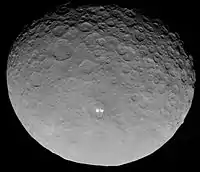| Discovery[1] | |
|---|---|
| Discovered by | LINEAR |
| Discovery site | Lincoln Lab ETS |
| Discovery date | 3 March 2000 |
| Designations | |
| (76146) 2000 EU16 | |
| 2002 TO288 | |
| main-belt · (middle) | |
| Orbital characteristics[2] | |
| Epoch 21 January 2022 (JD 2459600.5) | |
| Uncertainty parameter 0 | |
| Observation arc | 22.85 yr (8,345 days) |
| Aphelion | 2.5806 AU |
| Perihelion | 2.306 AU |
| 2.766 AU | |
| Eccentricity | 0.1665 |
| 4.60 yr (1,680 days) | |
| 130.990° | |
| 0° 12m 51.133s / day | |
| Inclination | 8.850° |
| 334.258° | |
| 347.850° | |
| Physical characteristics[2] | |
Mean diameter | 3.493±1.139 km |
| 0.252±0.112 | |
| 14.38[2][1] | |
(76146) 2000 EU16 is a small asteroid discovered on 3 March 2000, and the only known quasi-satellite of the dwarf planet asteroid 1 Ceres. From the perspective of Ceres, its orbit traces an analemma.[3]
References
- 1 2 "(76146) = 2000 EU16 = 2002 TO288". Minor Planet Center. International Astronomical Union. Retrieved 13 December 2021.
- 1 2 3 "JPL Small-Body Database Browser: 76146 (2000 EU16)" (2021-10-22 last obs.). Jet Propulsion Laboratory. Retrieved 13 December 2021.
- ↑ The analemma criterion: accidental quasi-satellites are indeed true quasi-satellites C. de la Fuente Marcos & R. de la Fuente Marcos, Monthly Notices of the Royal Astronomical Society, Volume 462, Issue 3, 01 November 2016, Pages 3344–3349
External links
This article is issued from Wikipedia. The text is licensed under Creative Commons - Attribution - Sharealike. Additional terms may apply for the media files.

